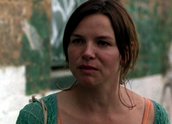


Look Both Ways (2005)
Synopsis
On the way home from her father’s funeral, Meryl (Justine Clarke), a young artist, sees a man killed by a passing train. Nick, a newspaper photographer (William McInnes) is sent to cover the accident, a few hours after being told he has cancer. Andy (Anthony Hayes), the journalist who writes the story, learns later that day that his occasional girlfriend Anna (Lisa Flanagan) is pregnant. While the widow of the dead man (Daniella Farinacci) tries to come to grips with her loss, Nick and Meryl begin a tentative relationship.
Curator’s notes
Look Both Ways was one of the great surprises of 2005. Australian production was in the dumps after a string of critical and commercial flops. Sarah Watt’s debut struck out in the direction suggested by Ray Lawrence’s Lantana four years earlier, towards adult drama with multiple characters that was serious, thoughtful and unashamedly emotional. The difference was that Look Both Ways was also very funny, in an original way.
Sarah Watt had won many awards for her very personal, painterly short animations. In writing her first feature she incorporated short flashes of animation, to give a sense of the inner lives of her characters. The film is still very personal (and somewhat autobiographical) but Watt’s script explores the emotions of six major characters, all of them connected by a single tragedy, rather than just one viewpoint. Indeed, that is the film’s main aim – to build up a sense of multiple voices, each of them caught up in an interlocking web. The series of ‘disaster animations’ take us inside Meryl’s thinking, but Watt uses a series of rapid photo montages to take us into the mind of Nick, the photographer played by William McInnes (Sarah Watt’s husband in real life).
One of the sub-themes is about the making of images, and how they are used. Nick’s photo of the accident scene shows the wife of the dead man reacting with horror. It’s used on the front page of the next day’s paper – without her permission. In a sense, the newspaper uses her grief for its own ends without a thought for her feelings. Nick has spent his life photographing other people’s grief in wars, famines and strife overseas – but he feels ashamed of this image, and the way it’s used. At the same time, we see that Meryl’s work is to paint moody landscape pictures that are used to illustrate sympathy cards. Both of them are part of the ‘public grief’ industry, in a sense. The film is partly about the way they react when the grief becomes much more personal. One of the strengths of the film is that it remains somewhat mysterious, open to many interpretations. There’s no such thing as normal in the film, which is a liberating starting point. It’s also a very optimistic film, despite the subject matter.
- Overview
- Curator’s notes
- Video 3 clips

- Principal credits
- Find a copy
- Make a comment
- Map
- Add your review



